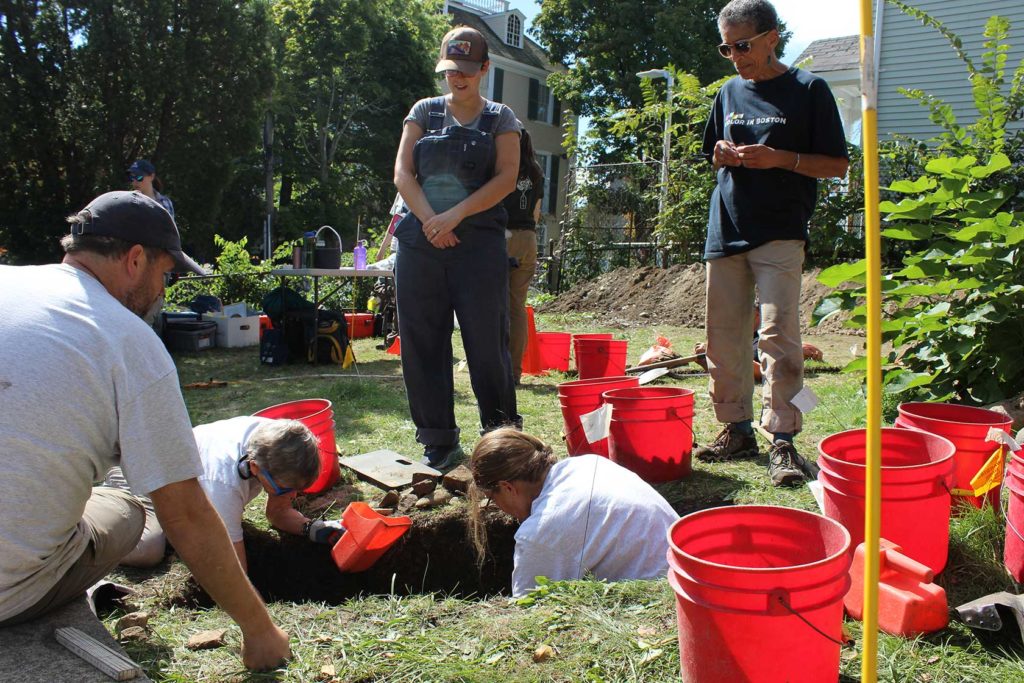
Across the street from the enormous Shirley-Eustis estate in Roxbury, the “outbuilding,” as it’s referred to, at 42-44 Shirley Street, has come into its own as a 18th-century landmark — prompting an investigation by the city archaeologist into what secrets may be hiding underground.
In 2021, the unassuming home with modern roofing and windows and a plain beige exterior was awarded landmark status after scholars found it to be one half of a former stable built around 1750 as part of a country home for Royal Governor William Shirley and his family. As such, city archaeologist Joe Bagley set out to discover hidden history beneath land that has remained largely untouched for hundreds of years, including that of enslaved people.
“At that point, the conclusion was made that the building at 42-44 was a stable building related to the Shirley Estate,” Bagley said. “And if it’s old enough to be before 1783, which we think it is, then it could also be related to the occupation of enslaved people in the home when it was a stable”
Bagley said he went to the current owner for permission — as the house is still privately owned and operated as a rental property, though currently unoccupied — and then started digging.
What Bagley and his team hope to find is the original footprint of the Shirley mansion, moved across the street in the 1860s. Based on their research, this would be a treasure trove of historical information.
“The reason why we were hoping that it was here is that the basement of that house was where the kitchens were, where the pantries were, and some of the living quarters for the enslaved people in the home. And if that was the case, and we find this in the yard, then that means that there’s this really historically important place that’s hiding in the ground that we didn’t know was still there until this day.”
The only known standing slave quarters in New England are at the Royall House and Slave Quarters in Medford.
“One of the things that we’re really trying to do with my program, for the city archaeology program, is to specifically look for places in the city where the stories of people who have been marginalized in Boston’s past,” Bagley said.

42-44 Shirley Street may have once housed people enslaved by the family of former
colonial Governor William Shirley. PHOTO: ANNA LAMB
On the Shirley property, five people with unique stories were enslaved. According to a press release sent out by the city, one was possibly an infant named Jane and the other was an 18-month old baby named Nanny, listed in her 1753 baptismal record at Kings Chapel as a servant of Catherine Shirley, Governor Shirley’s daughter. Nanny lived only four days.
Shirley’s other daughter, Elizabeth, and her husband, Eliakim Hutchinson, lived on the property and also enslaved two children, Affy and Cesar, and a man named Thomas Scipio.
“These five individuals, and likely others, were all present at the household in the mid-late 1700s,” the release states.
Suzy Buchanan, executive director of the Shirley-Eustis House Association, said the findings help remind people today about the realities of slavery in the North.
“As we continue to find more information about the particulars, the details of enslavement in New England, we find that the people that were enslaved had a rich variety of sophisticated skills with which they contributed to material comfort and to social life and to spiritual life,” she said, noting that many Americans today associate slavery with Southern agriculture.
Buchanan, whose team has continued to promote the work of the archaeologists, hopes to use the findings in future education in conjunction with the main estate.
What’s next?
As for the progress of the dig, Bagley said the findings so far raise more questions than answers.
“I’m almost certain that we have some part of the house foundation, the basement,” he said, “but what I’m really getting frustrated about is, I can’t tell where in that property I am at the moment.”
So far, the team has uncovered a series of what look like cobblestone walkways just beneath the grassy lawn.
Bagley said there are yet to be any defining features of the layout the team thinks is there, based on archival research done earlier this summer. He noted that in digs like this, basements can be defined by hole openings, and in the case of the Shirley Estate, proximity to its original driveway mapped out in 1870s drawings.
“We’re hoping that our current trenches that we are opening right now are going to help give us some more walls, essentially,” he said. “And then we can say this is a 12-foot-wide room, we’re definitely in the pantry, or this is a 15-foot-wide room. this is definitely the kitchen, there’s the base of the hearth.’”
If his suspicions are right, and the site is a kitchen and living quarters, beneath the surface they’ve uncovered could be another further-down layer of history. Bagley recounted the practice of West African slaves burying items of significance in the floors of 18th-century homes.
Those findings though, are off in the distance, as the archaeologist said his explicit goal is just to uncover the kitchen site and leave further decisions up to the descendants of the enslaved people of Boston.
“It’s really going to be up to the community,” he said.
The dig, which began Sept. 13, is set to finish this week. As for how the site will be preserved, Bagley’s team will simply put back the dirt. The current owner does not plan to disturb the site or alter the landscape, as it is protected by landmark rules.
“The best thing you can do with an archaeological site is to leave it alone,” Bagley said.






